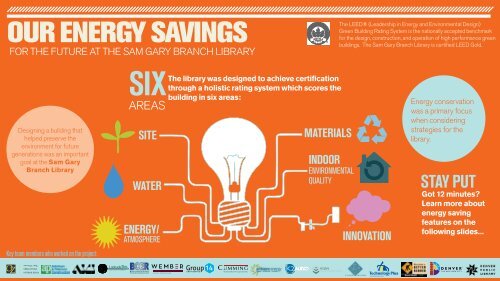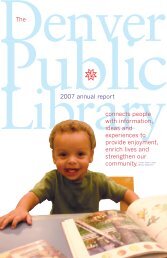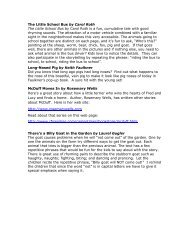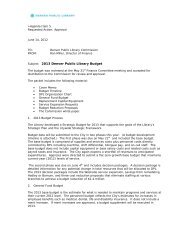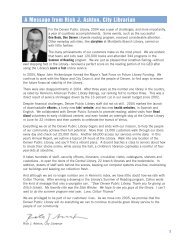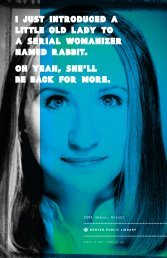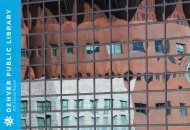LEED Gold - Denver Public Library
LEED Gold - Denver Public Library
LEED Gold - Denver Public Library
You also want an ePaper? Increase the reach of your titles
YUMPU automatically turns print PDFs into web optimized ePapers that Google loves.
our Energy savingsFOR THE FUTURE AT THE SAM GARY BRANCH LIBRARYThe <strong>LEED</strong>® (Leadership in Energy and Environmental Design)Green Building Rating System is the nationally accepted benchmarkfor the design, construction, and operation of high performance greenbuildings. The Sam Gary Branch <strong>Library</strong> is certified <strong>LEED</strong> <strong>Gold</strong>.Designing a building thathelped preserve theenvironment for futuregenerations was an importantgoal at the Sam GaryBranch <strong>Library</strong>Key team members who worked on the project:SIXAREASSiteWaterEnergy/AtmosphereThe library was designed to achieve certificationthrough a holistic rating system which scores thebuilding in six areas:MaterialsIndoorenvironmentalqualityInnovationEnergy conservationwas a primary focuswhen consideringstrategies for thelibrary.Stay PutGot 12 minutes?Learn more aboutenergy savingfeatures on thefollowing slides...Building Value Through ExpertiseKL&A,Structural Engineers and Builders
DAYLIGHTING & CONTROLSLighting fixtures in the library are programmed to dim as theamount of natural light increases. Sensor controls turn offlighting when spaces are unoccupied.Using natural light from the sun instead of electriclighting fixtures is a strategy called daylighting.“Sundolier” daylight harvestor tracks the path of the sun andfocuses light rays to reflectors to ensure consistent naturallight penetrates deep into spaces throughout the day.3 3 344Clerestory windows are utilized tocontrol introduction of daylightfrom above to avoid glare issues.1Direct Light at SouthFacing Facade2reflected lightDirect lightDiffused lightDiffused lightHigh performancelow-E glazing helps toblock heat transfer in orout while allowingdaylight into the space.Indirect Light from NorthFacing Side FacadeLight shelves Vertical fins solatubesand overhangs on the southand west sides of the<strong>Library</strong> bounce naturalsunlight deep into theinterior and block glare fromdirect sunlight that is hardon the eyes.on west facing windowsprovide passive sun controlby blocking the lower westsun in the summer to keepthe inside of the library cool.1 2 3on the roof use collectors toconcentrate natural daylightand flood the interior throughhighly reflective tubes, limitingthe need for electric lighting.They are so bright they areoften mistaken for light fixtures.
UNDERFLOOR AIR DISTRIBUTIONBelow your feetis an underfloor air distributionsystem commonly abbreviatedUFAD.Can you find me in the north - east corner?This is aDuct SockLook down... I am everywhereThis is amanual in-flooradjustablediffuserThis is aPower &Data BoxHeated andcooled air flowsthrough the spaceunder the floor andout the floordiffusers.Duct socksare fabric ducts that helpdistribute air to the far cornersof the room. UFAD systemsare more energy efficientbecause they can use slowerair speeds and don’t need toheat and cool the air as muchsince the air is deliveredthrough in floor diffusers atthe level of the occupants.individual comfort controlUFAD systems allow users moreindividual control over the temperaturein the immediate area throughadjustable diffusers that twist toproduce more or less air (Just like in anairplane). The library has several typesof floor diffusers: fixed, manuallyadjustable, and automaticallyadjustableCan you find me in the computing area?Greater flexibilityRaised floor tiles can be movedso power outlets, diffusers, andother controls can be easilymoved to different locations inthe floor. This allows greaterflexibility in space use andarrangement of furnishings.Typical air deliveredoverhead needs greaterair speed and is oftenoverheated or cooled tocompensate for themixing that occurs on theway down to occupantlevel.
BUILDING ENVELOPEis the first line of defense in keepingthe building comfortable.Because walls and roofs are passive systems they require no energy to perform, unlike activemechanical systems that need natural gas or electricity to function.High performanceglazingwith a low-E coating to keep heatoutside in the summer and heatinside in the winter.Saves energy, saves money.Wall & roof insulationprevent thermal transfer throughthe envelope.In addition to the typical batt insulationplaced between the framing, the wallsalso have an exterior layer of sprayfoam which insulates and air seals thestructure.Masonry thermal massHeat travels slower through thermalmass keeping the temperatureconstant inside.Thermal mass can be a benefit in thewinter as it continues to radiate storedheat after the sun goes down.
Sam Gary Branch <strong>Library</strong> Case Study<strong>Denver</strong>, COCommunityThe library is sited just north of the Stapleton Community Town Center at thecorner of 29 th Drive and Roslyn Street. The 28,500 sqft, single story buildingwill provide for the needs of the community, including children, teens, adultsand families. This library is unique to the <strong>Denver</strong> <strong>Public</strong> <strong>Library</strong> system in that itis a “hybrid” library style, merging the Family and Contemporary Servicelibrary styles, and it is one of the few library’s designed to meet <strong>Denver</strong>’s GreenPrint program requirements.Water ConservationColorado frequently experiences drought conditions so water conservation isimportant to maintain the water supply for all. The low flow plumbing fixturesin this restroom cut the water use to 30% of a typical building. Regional,drought tolerant landscaping saves additional water and requires littlemaintenance.How do the library plumbing fixturesachieve 30% water savings?The following water-saving plumbingfixtures have been installed in the library: Sloan Toilets, 1.28 gpf Sloan ADA Urinal, 0.125 gpf Sloan Bath Faucets, 0.5 gpm Chicago Faucets, 1.0 gpmHealthy Indoor Air QualityThe health of occupants was an important consideration when selectingmaterials for the library. Low VOC paints, sealants and adhesives createhealthy indoor spaces by not off-gassing into the surrounding air. Green LabelPlus certified carpet and FloorScore flooring contains no harmful chemical airpollutants. Carpet with lower VOC’s are an allergy and asthma friendly flooringoption. Walk-off mats at entrances help prevent particulates from beingtracked into the building. Additional features that contribute to good indoorair quality are related to the management of the facility. Carbon dioxidemonitors are tied to the ventilation system to increase the amount of outsideair provided when needed. Green housekeeping practices use safe, non-toxiccleaning agents and environmentally-friendly maintenance procedures for ahealthier indoor environment. The underfloor air distribution system hasmoisture sensors under the floor to help detect potential problems beforewater can cause damage or mold. The library is also a non-smoking facility.
Daylighting Strategies:Tubular skylights concentrate sunlight,illuminating rooms with natural light,eliminating the need for conventionallights.Light shelves help bounce sunlight deepwithin the building and dimmable lightfixtures automatically adjust based on theamount of daylight available.Clerestory windows maximize daylightavailability and cut down on the need foradditional electric lightingEnergy ConservationPassive systems were used at the library to reduce the load before introducingmechanical heating, cooling and lighting systems. The building envelope systemutilizes spray foam, fiberglass batt insulation and high performance low-Ewindows. The combination minimizes heat transfer through the wall,maximizing energy efficiency and reducing mechanical loads. The Light-coloredconcrete sidewalks, plaza and roof, in conjunction with shade trees, help toreduce the Heat Island Effect, which can raise the temperature in urban areas byas much as 10 degrees. These reflective surfaces also reduce the cooling load ofthe building.The primary heating and cooling system for the library utilizes an underfloorair delivery system, commonly abbreviated UFAD. A fan coil unit providessupplemental heat at the perimeter where heat is lost through the windows.UFAD systems deliver air closer to the occupants of the room. The mainarea of the library uses adjustable diffusers so visitors can adjust the amountof air near them to make it warmer or cooler. Small rooms designed toaccommodate groups have diffusers in thespace with thermostats that regulate thetemperature in response to heat generatedin the room. Underfloor air systems allowmore flexibility in the layout of furniture andsystems. Floor tiles with power and networkconnections can be rearranged as the needsof the space change. Duct sox are fabricducts under the floor that distribute air tothe far corners of the room. They inflatewhen filled with air and deflate when not inuse.Lighting in the library is tied to occupancy and daylight sensors to turn offlighting when it is not needed. Natural light is shown to boost productivity,and the reduction in electric lighting saves energy. Many daylightingstrategies were used throughout the building. As special art exhibithighlights the power of the sun with a daylight harvester that is installed onthe roof. It tracks the sun and focuses light on a reflector hanging from theceiling. A building automation system also cuts energy use by turning offequipment and lights when not in use. ENERGY STAR equipment is installedin the library to further cut energy use.Metal vertical fins on the building exteriorblock the heat and glare from the west sun.
Environmental MaterialsSustainable interior materials include rubber flooring consisting of granules ofrubber and a natural, rapidly-renewable material - cork. The bark of the CorkOak tree can be harvested every nine years and then grows back so it can beharvested again. This flooring is also FloorScore certified as a low-emittingproduct. The carpet contains recycled content and is also Green Label Pluscertified. The exterior of the library is constructed out of locally-produced brickand block which helps supports the local economy and cuts carbon emissionsby eliminating long-distance transportation. The gypsum board used to cladthe walls is both regionally produced and has high recycled content, utilizing aby-product of the coal industry (fly ash). Other products that contain recycledcontent are the gypsum ceiling tiles, insulation, doors, and many of the glassterrazzo countertops installed in the building.A recycling program has been implemented for staff and visitors that includesreceptacles for paper, glass, metal, plastic and cardboard. During construction,construction crews recycled 95% of the construction waste generated on-site.Materials were sorted into recycling dumpsters for each type of wastegenerated and taken to recycling centers.Sustainable Site FeaturesDespite the constraints ofthe site and the urbannature of the development,the community showedstrong interest in having anexterior gathering place tomeet and enjoy the libraryin conjunction with theoutdoors. An exteriorlandscaped plaza wasplaced adjacent to the mainentrance and provided withseating areas. The activeStapleton community will likely arrive with strollers and bikes so bike racks arealso provided in the plaza area and strollers can be placed in the large entrylobby. Biking and walking not only reduces carbon emissions but encourageshealthy lifestyles. All public areas of the library have views of the outdoors,with views of the mountains out of the west facing windows. The StapletonCommunity is sensitive to the surrounding environment. The exterior sitelighting uses full cut-off lighting fixtures which prevent light pollution,directing light down where it is needed, instead of up at the sky.About <strong>LEED</strong> and USGBC<strong>LEED</strong>® is an internationally recognized green building certification system, providing third-party verification that a building orcommunity was designed and built using strategies aimed at improving performance across all the metrics that matter most:energy savings, water efficiency, CO2 emissions reduction, improved indoor environmental quality, and stewardship of resourcesand sensitivity to their impacts.The U.S. Green Building Council® is committed to a prosperous and sustainable future for our nation through cost-efficient andenergy-saving green buildings. With a community comprising 78 local affiliates, more than 20,000 member companies andorganizations, and more than 140,000 <strong>LEED</strong>® Professionals, USGBC® is the driving force of an industry that is projected tocontribute $554 billion to the U.S. gross domestic product from 2009- 2013. USGBC leads an unlikely diverse constituency ofbuilders and environmentalists, corporations and nonprofit organizations, elected officials and concerned citizens, and teachersand students. USGBC is the developer of the <strong>LEED</strong> green building certification program and the convenor of the Greenbuild®International Conference & Expo.


